Evolutionary dynamics and emergence of panzootic H5N1 influenza viruses
- PMID: 18818732
- PMCID: PMC2533123
- DOI: 10.1371/journal.ppat.1000161
Evolutionary dynamics and emergence of panzootic H5N1 influenza viruses
Abstract
The highly pathogenic avian influenza (HPAI) H5N1 virus lineage has undergone extensive genetic reassortment with viruses from different sources to produce numerous H5N1 genotypes, and also developed into multiple genetically distinct sublineages in China. From there, the virus has spread to over 60 countries. The ecological success of this virus in diverse species of both poultry and wild birds with frequent introduction to humans suggests that it is a likely source of the next human pandemic. Therefore, the evolutionary and ecological characteristics of its emergence from wild birds into poultry are of considerable interest. Here, we apply the latest analytical techniques to infer the early evolutionary dynamics of H5N1 virus in the population from which it emerged (wild birds and domestic poultry). By estimating the time of most recent common ancestors of each gene segment, we show that the H5N1 prototype virus was likely introduced from wild birds into poultry as a non-reassortant low pathogenic avian influenza H5N1 virus and was not generated by reassortment in poultry. In contrast, more recent H5N1 genotypes were generated locally in aquatic poultry after the prototype virus (A/goose/Guangdong/1/96) introduction occurred, i.e., they were not a result of additional emergence from wild birds. We show that the H5N1 virus was introduced into Indonesia and Vietnam 3-6 months prior to detection of the first outbreaks in those countries. Population dynamics analyses revealed a rapid increase in the genetic diversity of A/goose/Guangdong/1/96 lineage viruses from mid-1999 to early 2000. Our results suggest that the transmission of reassortant viruses through the mixed poultry population in farms and markets in China has selected HPAI H5N1 viruses that are well adapted to multiple hosts and reduced the interspecies transmission barrier of those viruses.
Conflict of interest statement
The authors have declared that no competing interests exist.
Figures
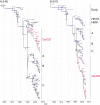
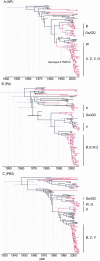
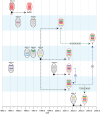
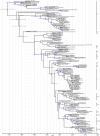
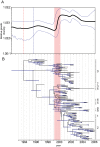
References
-
- Xu X, Subbarao K, Cox NJ, Guo Y. Genetic characterization of the pathogenic influenza A/Goose/Guangdong/1/96 (H5N1) virus: similarity of its hemagglutinin gene to those of H5N1 viruses from the 1997 outbreaks in Hong Kong. Virology. 1999;261:15–19. - PubMed
-
- Thiry E, Zicola D, Addie H, Egberink K, Hartmann H, et al. Highly pathogenic avian influenza in cats and other carnivores. Vet Microbiol. 2007;122:25–31. - PubMed
-
- World Health Organization. Cumulative number of confirmed human cases of Avian Influenza A (H5N1) reported to WHO (WHO, Geneva). 2008. Available: http://www.who.int/csr/disease/avian_influenza/country/en/. Accessed 11 August 2008.
-
- Li KS, Guan Y, Wang J, Smith GJD, Xu KM, et al. Genesis of a highly pathogenic and potentially pandemic H5N1 influenza virus in eastern Asia. Nature. 2004;430:209–213. - PubMed
Publication types
MeSH terms
Grants and funding
LinkOut - more resources
Full Text Sources
Medical

